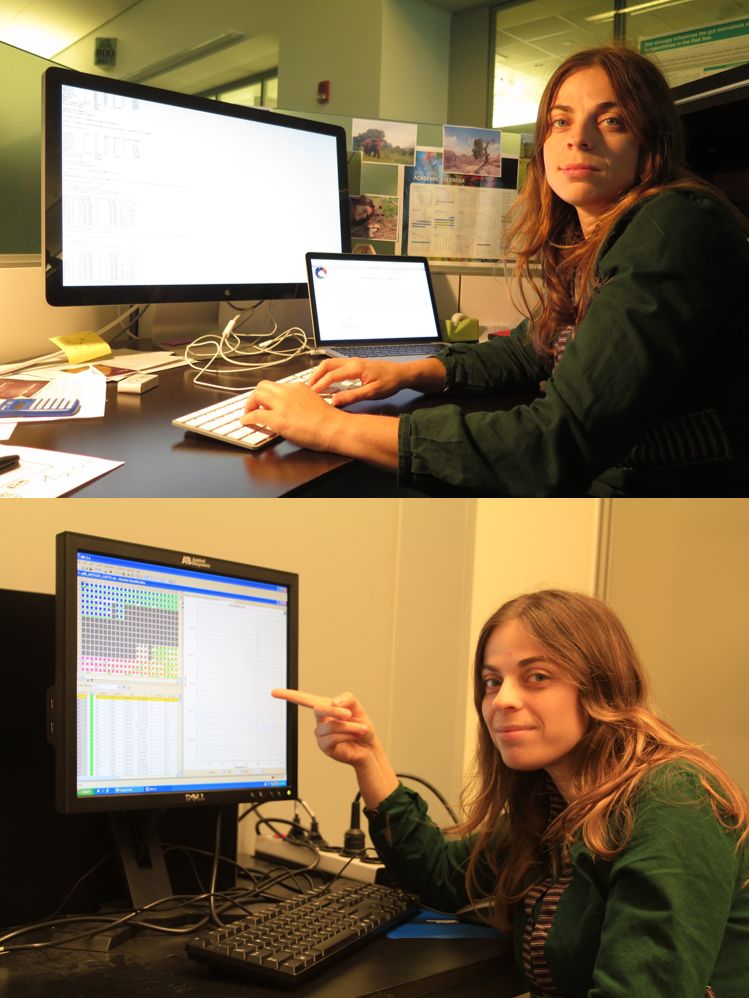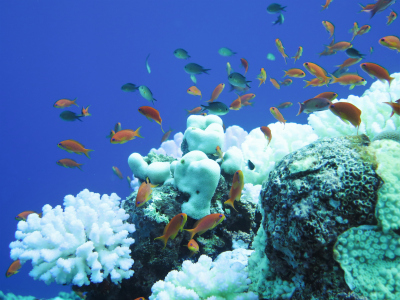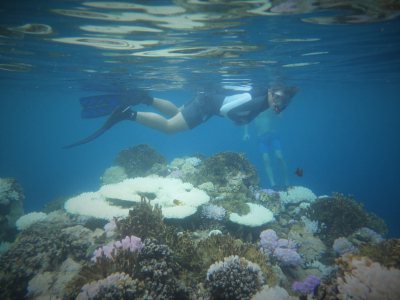Die Inhalte dieser Seite sind leider nicht auf Deutsch verfügbar.
Seitenpfad:
- Graduate School GLOMAR
- PhD student reports
- Research Placements
- Claudia Pogoreutz
Claudia Pogoreutz
Report of GLOMAR PhD student Claudia Pogoreutz about her research stay at the Coral Reef Genomics Lab of the King Abdullah University of Science and Technology (KAUST), Kingdom of Saudi Arabia from 1 October – 18 December 2015
I am a third year PhD student in the Coral Reef Ecology at the Leibniz Center for Tropical Marine Ecology GmbH (ZMT) in Bremen. My project is part of a very fruitful ongoing collaboration between the ZMT/Uni Bremen and the King Abdullah University of Science and Technology (KAUST) in Saudi Arabia, and investigates the responses of the coral Pocillopora verrucosa to increased concentrations of dissolved organic matter (DOM). More specifically, the projects teases apart individual responses of all major members of the coral holobiont – the coral animal host, symbiotic algae of the genus Symbiodinium, and coral tissue-associated bacteria – in order to increase our understanding of holobiont functioning. This was achieved by the application of a unique combination of more “traditional” physiological methods and state-of-the-art molecular methods to cover a wide range of critical holobiont functions, for example coral calcification, photosynthesis, or bacterial nitrogen fixation. Therefore, this project constitutes the most extensive effort to date to tackle the responses of the coral holobiont to the poorly investigated stressor DOM.
During my first and second year of my PhD term, I had already spent ten months in the lab of my KAUST-based Co-Supervisor Christian R. Voolstra in the Reef Genomics Lab. During this first stay, I successfully conducted two experiments, and finished most of my KAUST-based sample analysis together with Nils Rädecker (formerly Coral Reef Ecology Group at ZMT, currently PhD student at KAUST) and the PhD student Anny Cárdenas (MPI Marine Microbiology and ZMT). This fall, I returned to KAUST for a vigorous training in bioinformatics applications and real-time PCR or qPCR (quantitative polymerase chain reaction) approaches. These newly gained skills will be critical for the successful completion of my PhD project, and will also be useful for my future career. For now, they will allow me to proficiently analyze the molecular data generated during my previous stay, and to add one more critical analysis to my already extensive data set. More specifically, I learned to analyze NextGeneration Sequencing data of the coral-associated bacterial 16S rRNA gene and the ribosomal ITS2 region of Symbiodinium with both well established and recently developed unix-based bioinformatics applications in mothur. These applications allow the assessment of potential differential changes in the symbiont community composition in response to different treatments. On the other hand, the qPCR of the nifH gene, a functional gene for microbial nitrogen fixation activity, will enable me to further look into absolute and relative changes of the abundance of nitrogen-fixing coral-associated bacteria. Closely supervised by Prof. Voolstra, and thanks to the never-ending support of Nils, Anny, and Craig Michell, the resident specialist for PCR and sequencing applications, I learned a lot about the trouble shooting of unix-based pipelines for the analysis of high-throughput and high-resolution sequencing data sets, as well as the optimization of qPCR protocols for the relative and absolute quantification of target genes. Last but not least, the outlines for my final two manuscripts were discussed in detail with my co-workers and supervisors, which will help me speed up the writing process.
Slightly off-topic for the specific purpose of my research stay, but highly relevant for my field – stress responses of the coral holobiont to environmental change -, the third global coral bleaching event had been declared by the National Oceanic and Atmospheric Administration (NOAA) shortly after I returned to Saudi Arabia. In the past, mass coral bleaching has repeatedly been triggered by high ocean surface temperatures, and has been contributing to the decline of coral reefs worldwide. The first two global bleaching events took place in 1997/1998 and 2009/10, respectively. The current third global bleaching event had started in some regions already back in 2014, and due to a particularly strong el Niño this year, is predicted to – globally - last well into 2016. During my stay, parts of the Saudi Arabian Central Red Sea were affected. Therefore, one weekend in October I decided to join my colleague Nils Rädecker on a recreational snorkeling trip south of Jeddah, to observe the bleaching first-hand. This experience and the fact that the current global bleaching event occurred so shortly after the previous one really hammered home the message that it is now more important than ever to implement actions, not only to manage or mitigate the effects of local stressors, such as pollution, but also global climate change.
During my first and second year of my PhD term, I had already spent ten months in the lab of my KAUST-based Co-Supervisor Christian R. Voolstra in the Reef Genomics Lab. During this first stay, I successfully conducted two experiments, and finished most of my KAUST-based sample analysis together with Nils Rädecker (formerly Coral Reef Ecology Group at ZMT, currently PhD student at KAUST) and the PhD student Anny Cárdenas (MPI Marine Microbiology and ZMT). This fall, I returned to KAUST for a vigorous training in bioinformatics applications and real-time PCR or qPCR (quantitative polymerase chain reaction) approaches. These newly gained skills will be critical for the successful completion of my PhD project, and will also be useful for my future career. For now, they will allow me to proficiently analyze the molecular data generated during my previous stay, and to add one more critical analysis to my already extensive data set. More specifically, I learned to analyze NextGeneration Sequencing data of the coral-associated bacterial 16S rRNA gene and the ribosomal ITS2 region of Symbiodinium with both well established and recently developed unix-based bioinformatics applications in mothur. These applications allow the assessment of potential differential changes in the symbiont community composition in response to different treatments. On the other hand, the qPCR of the nifH gene, a functional gene for microbial nitrogen fixation activity, will enable me to further look into absolute and relative changes of the abundance of nitrogen-fixing coral-associated bacteria. Closely supervised by Prof. Voolstra, and thanks to the never-ending support of Nils, Anny, and Craig Michell, the resident specialist for PCR and sequencing applications, I learned a lot about the trouble shooting of unix-based pipelines for the analysis of high-throughput and high-resolution sequencing data sets, as well as the optimization of qPCR protocols for the relative and absolute quantification of target genes. Last but not least, the outlines for my final two manuscripts were discussed in detail with my co-workers and supervisors, which will help me speed up the writing process.
Slightly off-topic for the specific purpose of my research stay, but highly relevant for my field – stress responses of the coral holobiont to environmental change -, the third global coral bleaching event had been declared by the National Oceanic and Atmospheric Administration (NOAA) shortly after I returned to Saudi Arabia. In the past, mass coral bleaching has repeatedly been triggered by high ocean surface temperatures, and has been contributing to the decline of coral reefs worldwide. The first two global bleaching events took place in 1997/1998 and 2009/10, respectively. The current third global bleaching event had started in some regions already back in 2014, and due to a particularly strong el Niño this year, is predicted to – globally - last well into 2016. During my stay, parts of the Saudi Arabian Central Red Sea were affected. Therefore, one weekend in October I decided to join my colleague Nils Rädecker on a recreational snorkeling trip south of Jeddah, to observe the bleaching first-hand. This experience and the fact that the current global bleaching event occurred so shortly after the previous one really hammered home the message that it is now more important than ever to implement actions, not only to manage or mitigate the effects of local stressors, such as pollution, but also global climate change.
My second stay at KAUST has again been a very important stepping stone for my personal and professional development. I would like to thank my supervisors Prof. Wild and Prof. Voolstra for this invaluable opportunity. Also, I am deeply grateful to GLOMAR for the generous travel support. Finally, I would like to acknowledge funding for training and accommodation in KAUST by the baseline research funds of Coral Reef Genomics Lab of PI Christian R. Voolstra.
Further reading: the third global bleaching event
National Ocean and Atmospheric Administration declares third ever global bleaching event: http://www.noaanews.noaa.gov/stories2015/100815-noaa-declares-third-ever-global-coral-bleaching-event.html
Further reading: the third global bleaching event
National Ocean and Atmospheric Administration declares third ever global bleaching event: http://www.noaanews.noaa.gov/stories2015/100815-noaa-declares-third-ever-global-coral-bleaching-event.html
It is not easy to photographically document my last research stay at KAUST. While I learned a lot about many different applications, all of them involved a lot of sessions in front of a computer screen. Top: working hard to get a grip at mother to analyze sequence data. Bottom: checking the results of the last qPCR run
Bleached coral heads in the Southern Central Red Sea
Nils Rädecker, PhD student in the Reef Genomics Lab, checking out an offshore coral reef flat covered in bleached (white) and dead (brownish) corals





